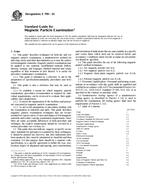Click here to purchase
1.1 This guide describes techniques for both dry and wet magnetic particle examination, a nondestructive method for detecting cracks and other discontinuities at or near the surface in ferromagnetic materials. Magnetic particle examination may be applied to raw material, semifinished material (billets, blooms, castings, and forgings), finished material and welds, regardless of heat treatment or lack thereof. It is useful for preventive maintenance examination.
1.1.1 This guide is intended as a reference to aid in the preparation of specifications/standards, procedures and techniques.
1.2 This guide is also a reference that may be used as follows:
1.2.1 To establish a means by which magnetic particle examination, procedures recommended or required by individual organizations, can be reviewed to evaluate their applicability and completeness.
1.2.2 To aid in the organization of the facilities and personnel concerned in magnetic particle examination.
1.2.3 To aid in the preparation of procedures dealing with the examination of materials and parts. This guide describes magnetic particle examination techniques that are recommended for a great variety of sizes and shapes of ferromagnetic materials and widely varying examination requirements. Since there are many acceptable differences in both procedure and technique, the explicit requirements should be covered by a written procedure (see Section 21 ).
1.3 This guide does not indicate, suggest, or specify acceptance standards for parts/pieces examined by these techniques. It should be pointed out, however, that after indications have been produced, they must be interpreted or classified and then evaluated. For this purpose there should be a separate code, specification, or a specific agreement to define the type, size, location, degree of alignment and spacing, area concentration, and orientation of indications that are unacceptable in a specific part versus those which need not be removed before part acceptance. Conditions where rework or repair are not permitted should be specified.
1.4 This guide describes the use of the following magnetic particle method techniques.
1.4.1 Dry magnetic powder (see 8.4 ),
1.4.2 Wet magnetic particle (see 8.5),
1.4.3 Magnetic slurry/paint magnetic particle (see 8.5.8 ), and
1.4.4 Polymer magnetic particle (see 8.5.8).
1.5 Personnel Qualification-Personnel performing examinations in accordance with this guide shall be qualified and certified in accordance with ASNT Recommended Practice No. SNT-TC-1A, ANSI/ASNT Standard CP-189, NAS 410, or as specified in the contract or purchase order.
1.6 Nondestructive Testing Agency-If a nondestructive testing agency as described in Practice E 543 is used to perform the examination, the testing agency shall meet the requirements of Practice E 543.
Product Details
- Published:
- 07/10/2001
- Number of Pages:
- 38
- File Size:
- 1 file , 670 KB
- Redline File Size:
- 2 files , 1.3 MB
